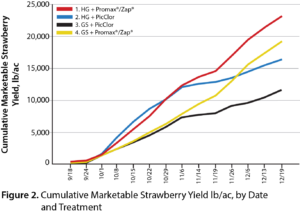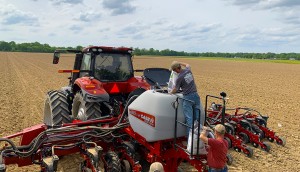For most farmers, April means the start of planting season. It’s a lot like opening day for a baseball team: heavy planning, great excitement and anticipation, lots of optimism and more than a few watch outs. So when exactly do farmers start planting? While they all have a plan, Mother Nature usually has the final say. There is an art and science to determining when to first drop the planter. Here are some key factors that determine the right time.
Soil temperature. Seeds of different crops are triggered to sprout, or germinate, at different soil temperatures. For corn, that’s 50 degrees; soybeans require 55 degrees; and cotton needs 64 degrees. You want to plant when the temperature is right for germination. Farmers can plant in slightly cooler soils if they are confident temperatures will soon rise. In my high-yield plots, I prefer a higher soil temperature for planting, with the belief that seeds will sprout quickly and maintain great vigor (uninterrupted growth). We have plenty of sun and heat in the South, so we have the luxury of waiting, whereas in the Midwest they need to capitalize on all the light and heat units they can acquire.
Soil moisture. Not too wet, not too dry. Sounds easy enough, huh? But that’s not always practical in the real world, especially when you never know what Mother Nature has in store. In Illinois, I used to target my grandma’s birthday, April 13, to plant corn. But that plan would often get disrupted by the weather. My old tried-but-true rule was passed down to me from my grandfather: grab a handful of soil, make a fist, and if the soil becomes a ball, it’s likely too wet to plant. Those who achieve the highest yields are typically the ones who plant when the soil is just right. That’s because plant vigor and uniform emergence – both products of planting in ideal moisture conditions – are key to growing high-yielding crops.
Acreage size. Typically, the more acres you farm, the earlier you need to start. Today’s big farming operations need to start early just to get everything in. They often subscribe to the mindset of erroring on planting early and a little too wet. The prevailing mindset is better to have it in as soon as you reasonably can (and risk early-season performance) than wait and have spring rains delay planting.
Crop insurance start date. With crop insurance covering about 90% of row-crop acres, farmers are obliged to wait until the start date of their coverage, no matter how antsy they get. These dates vary greatly depending on where you farm and are based on the risk of cold weather conditions. Corn in west Tennessee is March 21; where I farmed in western Illinois it’s April 5; in southern Minnesota it’s April 11. Soybean dates are usually about two weeks later. Changes in latitudes, changes in attitudes if you will.
Related Posts

4R Plus: Nutrient Management and Conservation for Healthier Soils
By now, most of us in agriculture have been made aware of the “4Rs” Nutrient Stewardship initiative—Right Source, Right Time, Right Rate, and Right Place—developed by The Fertilizer Institute, International Plant Nutrition Institute, Fertilizer Canada, and International Fertilizer Association. The 4Rs program advocates the implementation of best management practices that optimize the efficiency of fertilizer...

Huma Gro® Nutrient and Fumigation Replacement Program Increases Strawberry Yields 97%
Conducted by: Pacific Ag Research Huma Gro® Products: Ultra-Precision™ Blend (Fresca CA Strawberry Mix), Promax®, and Zap® OBJECTIVE This field trial assessed the effects on strawberry yields of replacing field fumigation with periodic applications of Huma Gro® Promax® and Zap® and replacing a grower’s standard fertilizer program with irrigation-applied Ultra-Precision™ blended liquid Huma Gro® crop...

This Week in Ag #40
I’ll never forget the sage words an old farmer told me when I announced my intention to start farming in the late 1990s. I explained that I was not leaving my marketing job and that I was also doing a fair amount of freelance consulting work. He told me, “It’s funny how many other jobs you need...

